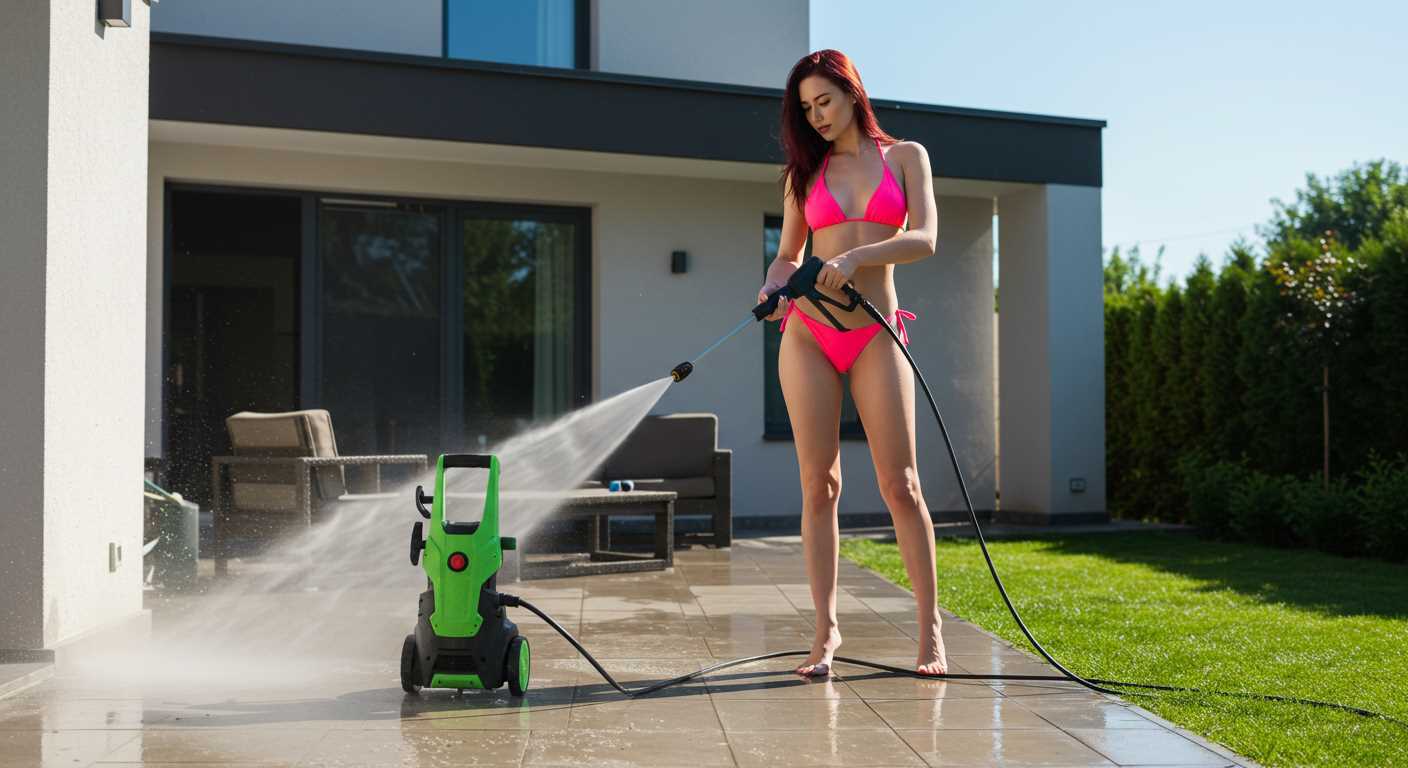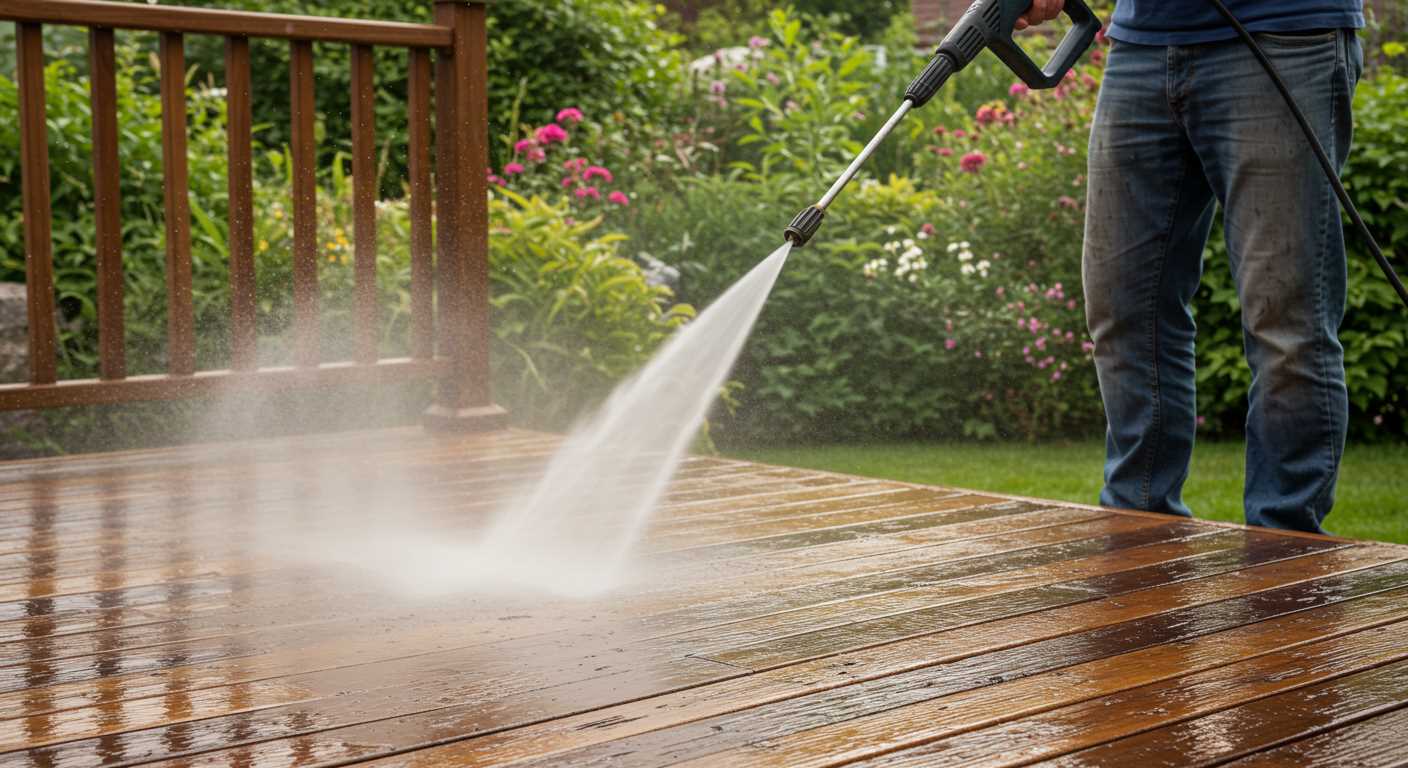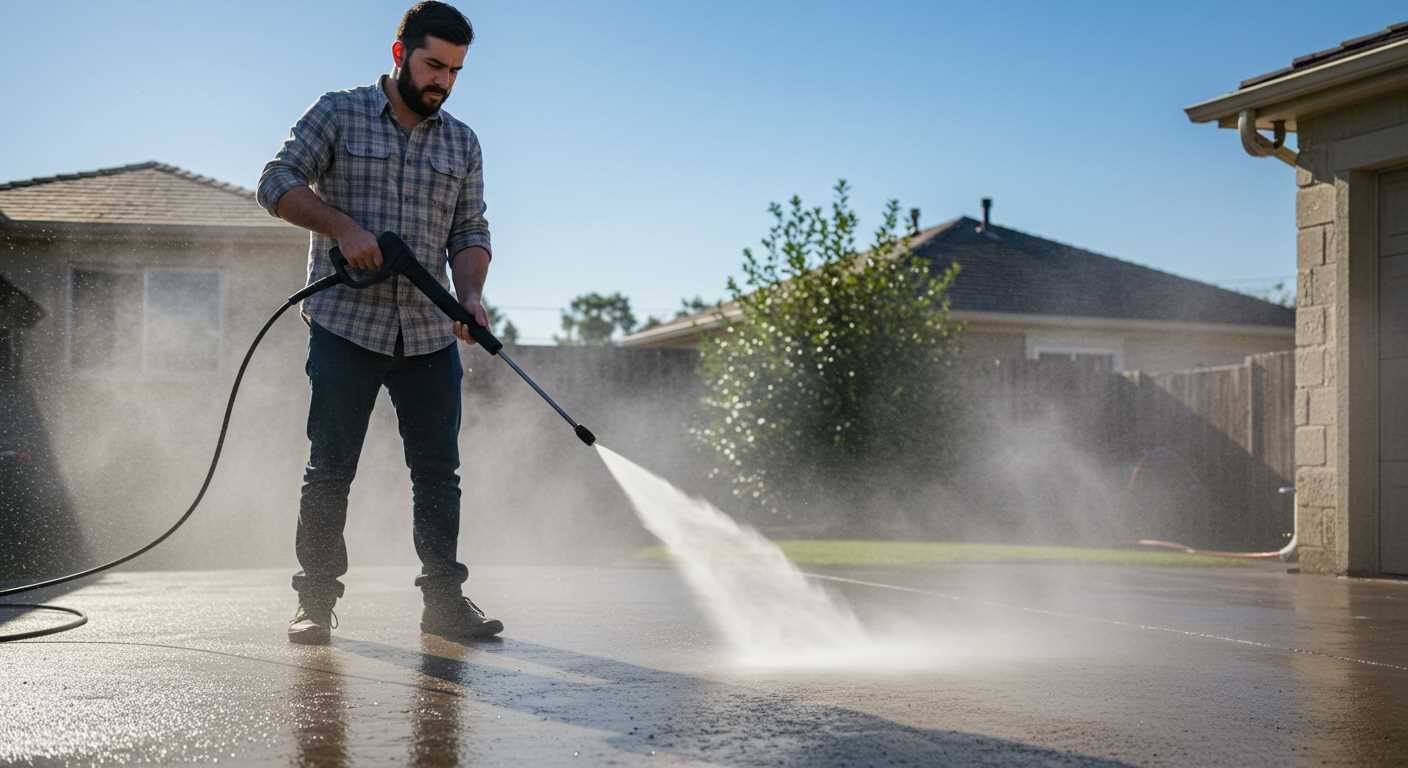



For those looking to rejuvenate their outdoor surfaces, utilising a high-pressure cleaner is unmatched. First, ensure you have the right equipment: a machine with adjustable pressure settings will give you both power and control. I recommend a model that offers at least 2000 PSI to effectively tackle grime without damaging the surface beneath.
Before beginning, prepare the area thoroughly. Clear away furniture, potted plants, and any debris to avoid complications during the process. A good initial sweep with a broom can prevent larger particles from becoming airborne when you start washing.
Mix the right cleaning solution with water according to the manufacturer’s instructions–opt for biodegradable options to protect your surroundings. Test a small, inconspicuous area first to ensure compatibility. Adjust nozzle settings: a wide fan for delicate areas, or a narrower stream for stubborn stains.
As you move methodically, maintain a consistent distance from the surface, usually around 12 to 18 inches. Overlapping strokes will ensure even coverage while preventing streaks. After completing the washing, allow the area to dry completely before placing items back, ensuring the optimal appearance and longevity.
Steps for Restoring a Timber Surface Using a High-Pressure Cleaner

Before using a high-pressure cleaner on your timber surface, prepare the area by removing all furniture, plants, and any debris. This ensures unobstructed access and prevents damage to your belongings.
Select a suitable nozzle, ideally a fan or rotating nozzle for broader coverage. Adjust the pressure setting to avoid damaging the timber; a setting between 1500 to 2000 psi typically works well.
Begin washing from one end and work systematically towards the other, maintaining a distance of around 12 inches from the surface. This helps avoid gouges or marks.
- Use sweeping motions, overlapping each pass to ensure thorough coverage.
- Pay special attention to heavily stained areas, allowing extra cleaning solution to dwell for a few moments before rinsing.
- Do not linger too long in one spot to prevent etching into the material.
After rinsing, inspect your work. If stubborn stains remain, repeat the process only on affected areas. You can also apply a mild cleaning solution designed specifically for timber surfaces to aid in removing tough stains.
Finally, allow adequate time for the timber to dry before applying any sealants or stains. This process enhances the surface’s longevity and protects it from future wear.
Choosing the Right Equipment for Your Surface

For optimal results, consider machines that offer at least 2000 PSI (pounds per square inch) of pressure; this power level effectively removes dirt and mildew without causing damage. Look for models featuring adjustable nozzles, allowing for versatility in control over water flow and pressure.
Identify a unit that has a flow rate of 1.5 to 3.0 GPM (gallons per minute). This range ensures sufficient water output for achieving thorough rinsing, especially important for textured surfaces where dirt can accumulate. Remember, compatibility of nozzles can enhance your cleaning session by tailoring the spray to suit different areas.
A machine equipped with an electric motor is quieter and requires less maintenance than gas-powered options, making it ideal for residential use. If you expect to operate for extended periods or tackle larger areas, consider a gas unit; these tend to offer higher performance levels and longer runtimes.
Weight and portability are also significant factors; a lightweight model will minimise fatigue during use. Look for sturdy wheels that can navigate uneven surfaces easily.
Lastly, evaluate the availability of attachments. Brushes and surface cleaners can expedite the process and deliver better outcomes, ensuring all areas are treated effectively. Investing in a quality machine will not only make your task easier but will also prolong the life of the outdoor area.
Preparing Your Deck for Pressure Washing
Before engaging in the washing process, ensure that the area is clear of furniture, potted plants, and any other items that might obstruct access. This includes removing all decorative features that could be damaged or impede your progress.
Next, inspect the surface for any loose boards, nail heads, or protruding screws. Secure these with screws or wood glue, as any loose materials might create hazards or affect the performance of your equipment.
Surface Inspection and Repairs
Check for mould, mildew, or any stains that require pre-treatment. For stubborn growths, consider using a dedicated solution designed for removing such contaminants. Apply it according to manufacturer instructions and allow ample time for it to take effect before rinsing.
Assess the condition of the timber. If you notice significant wear, sanding may be necessary to smooth rough patches and prep the area. This also aids in ensuring a uniform finish post wash.
Safety Measures

Always prioritise safety. Wear protective eyewear, gloves, and non-slip shoes while working. Depending on the height of the structure, you may need a sturdy ladder for hard-to-reach spots.
Lastly, ensure your chosen equipment is suited to the task. Familiarise yourself with the settings and operate according to the guidelines, paying attention to the pressure settings recommended for timber surfaces.
Follow these preparatory steps to ensure a seamless and efficient washing experience, maximising the longevity and appeal of your outdoor space.
Selecting Appropriate Cleaning Solutions for Wood
I recommend beginning with a pH-balanced cleaner designed for natural surfaces. Such solutions efficiently eliminate grime without compromising the integrity of the fibres. Look for biodegradable options to ensure environmental safety and minimize chemical residues.
For heavily stained or mildewed areas, a soft wash solution containing sodium hypochlorite can be beneficial. It effectively targets organic growth without being overly harsh. Always dilute as per manufacturer’s instructions before application to avoid potential damage.
A common alternative is oxalic acid, particularly useful for restoring discoloured timber. This compound lightens dark spots and mildew stains, making surfaces look more uniform. Apply it selectively and rinse thoroughly after usage.
Ensure that any cleaning agent is specifically formulated for outdoor applications. Using indoor cleaners can result in ineffective results and potential damage due to harsh chemicals not suited for exposure to elements.
| Cleaning Solution | Use Case | Notes |
|---|---|---|
| pH-balanced cleaner | General cleaning | Safe for regular use |
| Sodium hypochlorite | Stains and mildew | Dilute according to instructions |
| Oxalic acid | Restoration of discoloured surfaces | Use selectively, rinse thoroughly |
| Biodegradable cleaner | All-purpose eco-friendly option | Minimises environmental impact |
Before final choice, conduct a small test on a hidden area. This precaution will help ensure compatibility with your timber, facilitating effective and safe restoration. Always follow up with a thorough rinse to remove any residue left by the cleaners.
Setting the Correct Pressure and Nozzle for Wood Surfaces

Adjust the pressure settings between 1,200 to 1,500 PSI. This range is ideal for maintaining the integrity of the material while removing dirt and grime effectively.
Select a nozzle that is compatible with these pressures. A 25-degree or 40-degree nozzle is best for softer surfaces, as they provide a wider spray pattern that disperses water over a larger area, reducing the risk of damage.
- 25-degree nozzle: Suitable for general cleaning. Offers a balance between pressure and coverage.
- 40-degree nozzle: Best for delicate areas. Minimises the risk of gouging the surface.
Keep the nozzle at a distance of at least 12-18 inches from the surface to prevent splintering and other damage. Maintain a consistent motion to avoid streaking and uneven wear.
In specific areas that require more focus, like stains or mildew patches, you can get slightly closer (about 6-12 inches). However, exercise caution and adjust the pressure down if necessary.
Monitor the performance regularly. If the water does not seem to be removing stubborn marks, try adjusting the angle of the nozzle instead of increasing the pressure.
Techniques for Pressure Washing Without Damaging Wood
Maintain a distance of at least 30 centimetres between the nozzle and the surface. Reducing pressure can prevent gouging or etching the fibres.
Utilise a fan-shaped nozzle, preferably 15 or 25 degrees, to distribute the force evenly while cleaning. A narrow jet can easily strip away protective coatings.
Move the nozzle in a sweeping motion, following the wood grain. This technique minimises the risk of water penetrating too deeply into the material.
Adjust the pressure settings to a lower range, around 1200 to 1500 PSI, sufficient to remove dirt without compromising the integrity of the timber.
Use overlapping strokes while washing, ensuring you don’t linger in one spot. This prevents water from pooling and allows for more uniform treatment.
Test a small inconspicuous area before proceeding to the entire surface. This ensures your technique and chosen settings are safe for the type of timber.
Work in sections, allowing each area to dry before moving on. This helps in observing any potential damage that may arise from the cleaning process.
Consider background conditions such as temperature and humidity, as excessive heat or moisture can affect the cleaning outcomes and the material’s reaction.
Always keep the equipment moving to avoid concentrated pressure on a single spot, which could result in permanent damage to the surface.
Post-washing, allow adequate drying time to ensure the timber regains its natural state before applying any sealants or finishes.
Post-Cleaning Care and Maintenance for Your Deck
Apply a high-quality sealant to protect from moisture and UV damage. Ensure the surface is thoroughly dry before application, ideally 24-48 hours after washing. Choose a sealant based on the deck’s wood type, aiming for products designed specifically for outdoor use.
Regular Inspection
Conduct routine inspections every few months. Look for signs of wear such as splintering, mould, or faded areas. Address any issues immediately to prevent further deterioration. Reapply sealant or stain as needed, typically every one to three years, depending on environmental conditions and usage.
Debris Removal
Keep the surface free of leaves, dirt, and other debris. Regular sweeping prevents moisture retention and mould growth. After heavy rains or storms, inspect for accumulated debris and clear it away promptly to maintain the integrity of the finish.
FAQ:
What preparation is necessary before cleaning a wooden deck with a pressure washer?
Before using a pressure washer on your wooden deck, it is important to do some preliminary tasks to ensure an effective cleaning process. First, clear the deck of any furniture, planters, or decorations. This not only provides a clear workspace but also prevents damage to your belongings. Next, sweep or blow away any dirt, leaves, and debris to ensure that the pressure washer doesn’t simply push this material into the wood. Additionally, inspect the deck for any loose boards or nails; secure them to avoid further damage during cleaning. It might also be beneficial to let the deck dry if it has been recently rained on, as wet wood can absorb more pressure and potentially splinter.
How should I adjust the pressure and nozzle settings on my pressure washer for cleaning a wooden deck?
Adjusting the pressure and nozzle settings properly is crucial for cleaning a wooden deck without causing damage. Use a nozzle with a wide spray pattern, typically a 25-degree nozzle, as it disperses the water to reduce the risk of gouging the wood. For pressure settings, a range of 1200 to 1500 PSI is generally suitable for wooden decks. Higher pressures can damage the wood grain, while lower pressures might not effectively remove dirt and mildew. Maintain a distance of about 12 to 18 inches from the surface while washing, and keep the nozzle moving to avoid concentrating the water on any specific spot for too long, which can lead to splintering.










